|
Reptile Vet Care
Little Critters in Gilbert AZ
|
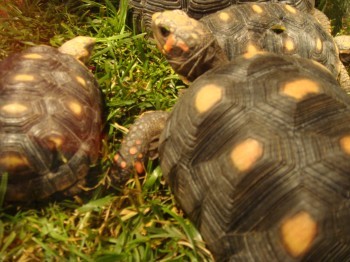
|
|
REPTILE INFORMATION INTRODUCTION
Reptiles are fascinating creatures which I enjoy caring for. Unfortunately, many of the patients I see in practice suffer from chronic malnutrition due to both a poor diet and an inadequate environment. I’ve started this web page so that I could have a readily accessible forum in which to post information that I hope will improve the care of these wonderful animals. Also included, will be links to web sites that I often refer clients to and which have extensive libraries on reptile care.
What you need to know about your pet’s requirements:
How and what to feed, Proper Environmental Temperature, Humidity Level
Most of the medical problems in these guys stem from a lack of knowledge on the owners part about the specific needs of the pet. The most important thing you can do to provide your reptile with a long and healthy life is to READ. I can guarantee you that the more you know about your particular pet the better that pet’s life will be. There are many types of reptiles available and they all come from different environments and have different requirements for nutrition and environment. So, I encourage you to read as much material as you can get your hands for your particular type of reptile. Not everyone agrees on “exactly” how an individual reptile should be fed and cared for, but there are many accepted basics that you need to know. I believe that as long as you know the basics about your pet’s wild lifestyle and strive to mimic that as closely as possible; you’ll be providing better care than 99% of the population.
|
|
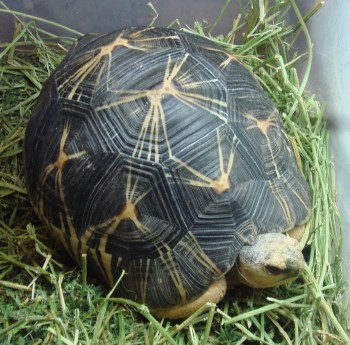
|
|
Turtles/Tortoises: Chelonians
Tortoises: Are largely herbivore which means that their primary diet should be composed of vegetable matter. Have an upper and lower shell that does not close and no webbing between their toes. The most common problem we see in pet tortoises is the over feeding of protein (dog food) to these guys. Again, you need to research the specific needs for your individual pet, but generally speaking tortoises should have about 80-85% of their diet comprised of leafy greens, mixed veggies and hay. In warm climates the best way to care for most adult tortoises is to allow them to graze outside and supplement some assorted leafy greens and veggies. Tortoises can also be fed fruits, but this should be a small part of their diet and given more as treats than the staple of their diet. Malnutrition in these animals can also be compounded by coprophagy (the eating of their feces) and a captive environment. These two issues lead to increased parasite burden in our captive tortoises. A regular part of their yearly exam should include fecal examination for parasite ova (eggs). I recommend that you always bring a fresh fecal sample with you when visiting the vet. There isn’t anything we love better!
Most importantly, prior to buying a tortoise, please research the needs of the animal you are planning on adopting. To provide adequate care you need to understand their nutritional and environmental needs in addition to their longevity and eventual size.
Some types of tortoise can become very large, such as this Sulcata. These large pets can be destructive diggers and require a very roomy outdoor enclosure.
|
|
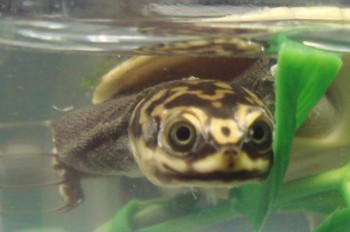
|
|
Aquatic Turtles
Are largely carnivores – meat eaters. Have webbing between their toes One of the more common problems we see in turtles is upper respiratory infection associated with vitamin A deficiency and poor hygiene. Signs include bubbles from the eyes and nostrils, itchy eyes with rubbing of eyes by front legs, swollen eyes (conjunctiva), open mouth breathing and gasping. Unfortunately, in captivity many turtles are kept in dirty environments with water that has been fouled by their food source and feces. It is best to feed turtles in a water source separate from their swimming pool. When artificially confining turtles to captive environments cage hygiene must be an important part of the pet’s upkeep. Food sources for turtles include formulated diets fortified with vitamins and minerals, live food such as small fish, and veggies high in vitamin A for the youngsters.
|
|
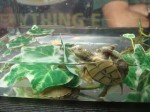
|
|
1) Food:veggies, proteins, fruits 2) Environment: Clean swimming pool with filtration system. An area to dry dock is necessary. Full spectrum lighting – provided by sunlight not filtered through glass, or a fluorescent full spectrum lamp. The lamp should state that it provides both UVA & UVB light. Warmth should be ensured if kept outdoors. Indoors, environmental temperatures often will suffice but I like to include an incandescent bulb for “basking in the sun.”
|
|
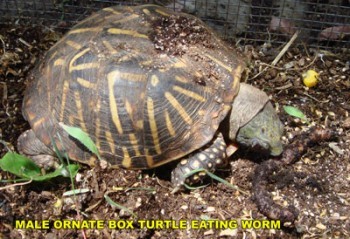
|
|
Box Turtles
Are omnivores – eating both plants and animal products. Are land animals Have a lower shell (plastron) with a “hinge” to allow them to close their shell. These guys should be fed a mixture of protein based food and veggies. Cat food should never be fed. Some suggestions for protein sources include small fish, insects, and formulated parrot diets. Assorted vegetables and fruits should also be offered to the pet box turtle. A common problem with box turtles is that if allowed they will consume only their favorite food and often ingest too much protein. A few ways around this include feeding only veggies when they are the hungriest and mixing food thoroughly to attempt to reduce their ability to pick out individual components. Box turtles should be supplemented with a calcium product and a multivitamin when young. Hygiene is also important with these turtles and can especially be a problem because they will frequently defecate in their water source leading to increased bacteria and parasite loads. Box turtles require a high environmental humidity level and should have access to a very shallow pool of clean water at all times. The water must be cleaned daily because turtles will typically defecate while soaking. Box turtles should be fed a mixture of vegetables and protein. They are often deficient in vitamin A so a vegetable rich source should be fed daily such as squash, sweet potatoes and peppers. I’ve provided a link below for a formulated turtle diet (turtle brittle) that can comprise a portion of their diet (the protein). A variety of greens should also be fed daily and a limited portion of fruits and berries. All food should be finely diced when served.
|
|
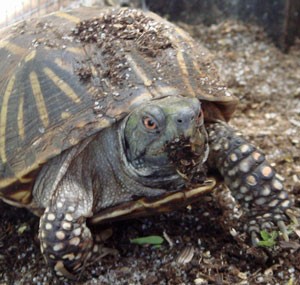
|
|
Flooring:
Preservative and chemical free soil or mulch rich in coconut bark and sphagnum moss will allow the turtle to burrow and will also help to maintain high humidity levels. Water: A shallow pool of water should be kept in the enclosure and should be cleaned daily. Turtles will drown in deep water so the pool should only be about 1in deep and should have easy access for entering and exiting. Again, it is very important to keep the pool water clean to avoid bacterial build up and infections.
Shelter: If kept outdoors natural plant shelter is best and is needed to allow cooling, but if the turtle is kept indoors artificial plants can be placed around the enclosure and will provide the same feeling of shelter and security for the turtle.
Lighting: Sunlight is always the best, but if kept indoors the enclosure should have a full spectrum (UVA and UVB) light within 18in. of the floor and a basking light to allow for additional warmth.
Temperature: Average indoor temperatures are usually appropriate, but again a basking light should be provided to allow for additional heating up to about 85F.
Supplementation: Food should be sprinkled with a phosphorus free calcium supplement.
|
|

|
|
Common Disease Problems: The most common problems we see in turtles are always related to an inadequate diet and environment. The best way to keep your pet healthy is to practice preventative medicine which is really just providing a good diet and environment. A problem we commonly see in turtles is respiratory infection related to vitamin A deficiency and too dry an environment. These turtles will have swollen eyes, bubbles form their nostrils and eyes and may sound congested. Many will be unable to open their eyes and may also have stopped eating
Turtle/Tortoise Generalizations:
Nutritional needs will vary with species Will benefit from regular sunlight Often suffer from malnutrition, parasites and bacterial infections If allowing your turtle or tortoise to graze in your yard be aware of potential predators including the family dog. We frequently see injured turtles that the family dog thought would be a great chew toy.
|
|
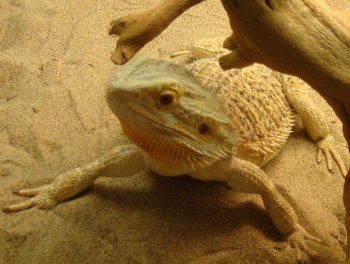
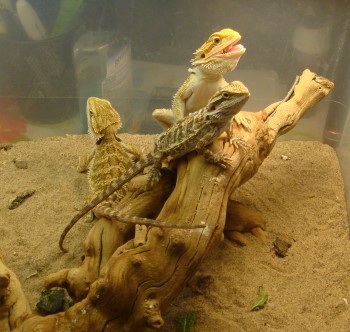
|
|
|
Bearded Dragons:
Are omnivores: eating a mixture of plants and animal products, but the bulk of the diet is protein based. Common problems are similar as with other reptiles and include malnutrition from improper lighting and feeding. They often suffer from parasite infections and should be examined yearly. Bring a fecal sample! Hatchling bearded dragons have to be fed very small live food which sometimes can be difficult to obtain and hatchlings are more fragile. It is best to start with a slightly older dragon that can be fed readily available food.
A QUICK FACT SHEET
ENVIRONMENT: Desert of Australia
LIFESPAN: 10+ years of age
SEXING: Males have a beard that turns black during the breeding season
Males have pre-anal and femoral pores
HOUSING: – A large aquarium with a natural substrate bottom and multiple climbing branches and hide boxes should be used.
The type of substrate is often debated but may people advocate bedding such as sand, outdoor carpet, decomposed granite, paper towels, newspaper… Regardless of the type of substrate used, hygiene is the most important aspect to consider. You should choose a substrate that you can keep clean and fresh for your dragon.
Avoid: kitty litter, bird litter (such as corncob or walnut shells) and wood shavings.
LIGHTING: Full spectrum lighting can only be supplied in the form of fluorescent bulbs and the bulb must supply UVB spectrum light. The light should be ~18 inches from the cage.
A basking light should be provided in the form of an incandescent bulb placed above a branch.
TEMPERATURE: A range or temperature gradient should be supplied with the cool end of the cage at ~75F and the warm end up to 86F. Night time temperatures can dip down to the 70’s. The basking light should provide a focal spot in the 90’s range.
WATER/HUMIDITY: A shallow drinking dish should be provided Occasional misting with a spray bottle can be provided.
DIET: These guys are omnivores: they eat protein and veggies. Very Young: Pin head crickets must be provided, feeding these hatchlings too large an insect can result in their death. Assorted shredded veggies. Immature: larger insects – a variety should be provided.
Adults: As the lizards grow larger they can be fed mice or other rodents.
SUPPLEMENTS: The insects should be dusted with a phosphorus free calcium supplement prior to feeding. A multi vitamin should be provided twice weekly.
MEDICAL CONCERNS: – Parasite infections are very common in bearded dragons and will often result in cloaca irritation and prolapse.
Malnutrition and metabolic bone disease due to poor lighting and diet. Gut impaction Remember: A yearly veterinary examination is needed to keep your dragon healthy.
CONCLUSION: Dragons can make excellent pets and I often recommend them to people considering purchasing a lizard. One benefit of dragons is that they don’t grow as large as iguanas and they tend not to become aggressive. But, like all exotic pets they have very special needs and the potential owner should become educated prior to purchasing these pets. Also, remember that adult dragons must be fed a larger protein source such as mice and rats. If you aren’t comfortable feeding this type of prey then a dragon is not for you.
|
|
|
|
|
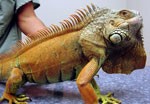
|
|
Iguanas:
Iguanas are herbivores – eat veggies. Iguanas are a lizard that I do not recommend purchasing as a pet unless you understand and are willing to provide for all their very special needs. These guys will grow to be very large and males often become aggressive, have razor sharp teeth that can cause serious injury, and a strong tail that can be used like a whip. When buying an iguana (or any reptile) it is important to first research their needs and be certain that you can provide the space, diet and environment that they require. It is not uncommon to see advanced metabolic bone disease in Iguanas due to poor diet and environment. MBD is a lack of bone density due to low calcium and vitamin D (or sunlight) in the diet. MBD results in scoliosis, fractures and inability to walk.
|
|
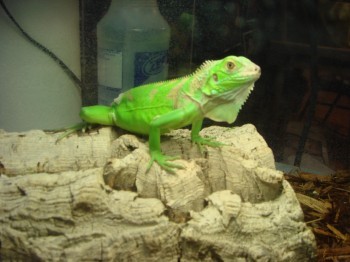
|
|
We also frequently see adult iguana that have become so large that they cannot be kept by their current owners. Unfortunately many of the iguana rescue groups are full to overflowing with rescued iguanas and are not always able to provide a home for these guys. lease realize that these guys get very large and be certain that you’ll be able to care for they later in life before you buy that baby iguana. I recommend feeding a mixed leafy green salad with diced veggies daily. These guys will also need a calcium supplement (phosphorus free) and either direct sunlight or a vitamin D supplement as part of a multivitamin.
Another problem with iguanas is dehydration and kidney disease. They need much higher humidity levels than we are often able to provide in captivity. I suggest soaking in warm shallow water daily to improve hydration. Kidney disease is often linked to high dietary protein intake. Iguanas are not carnivores and should not be fed dog food.
|
|
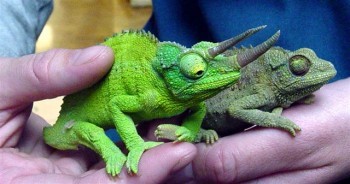
|
|
Chameleons:
I love chameleons and personally find them to be the most fascinating of the reptiles. However, I typically don’t recommend them as pets because they have very specialized needs and can be very frail in captivity with sudden death not uncommon.
Unique Characteristics:
-Their feet have toe bones fused into a specialized foot that allows them to climb & grasp.
– They have the ability to change skin color and will often change color when stressed.
– Their eyes can rotate independently.
– The chameleon family includes both egg bearers and live bearers.
– They spend their lives in the trees and foliage
– They drink rain drops off of leaves
– They have a long projectile tongue enabling them to catch prey
– They are solitary animals.
– Males often have head ornamentation.
– They require live food – insects.
– They must be housed with plants to provide them with a feeling of security. A drip system must be implemented to water them. There are several commercial productsavailable but a drip system can easily be home made by placing a bowl on top of the cage with a pin hole on the bottom to allow water to drip through the foliage and into a receiving bowl. They will not drink out of a bowl so the water must drip over the plant material. Alternatively, the plants can be misted several times daily.
Each type of chameleon will have special needs, but generally speaking they all require a source of sunlight, humidity, varied insects that have been supplemented, and a heat source.
One of the best things you can do for your chameleon is to provide them with regular sunlight. The sun should not be filtered through glass because this limits the absorption of UV rays.
Problems Requiring Medical Attention ASAP:
- – Refusal to feed
- – inability to open eyes
- – swollen eyes
- – inability to grasp or climb
- – oral lesions
Sick chameleons tend to become critical in a short period of time and should be examine by a veterinarian at the first sign of trouble.
|
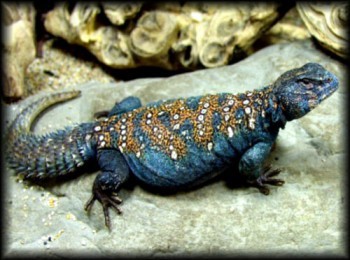 |
|
UROMASTYX LIZARDS
MY FAVORITE LIZARDS
Care Sheet for Uromastyx Reprinted with permission, by: Troy Jones – Uroranch
Feeding Uromastyx.
Feeding a mix of Spring Mix, Endive, Escarole, Dandelions, Dandelion Greens, Mustard Greens, Turnip Greens, Collard Greens, Bok Choy, and some Kale. I remove the stems and tear the greens into small pieces and bag them in one gallon zip lock bags.
It is also good idea to add edible flowers to the mix such as Hibiscus, Hollyhock, Dandelion, Cat’s Ear, Birds Foot Trifoil, Etc. I usually feed green peas or thawed mixed vegetables about once a week to give them a break from greens. About once a week I lightly dust their food with indoor version of Miner All calcium supplement. I also keep a small bowl of uncooked (ground up) green peas, lentils, various beans and birdseed. It has been suggested (I believe by Audrey Vanderlinden) to occasionally add pure bee pollen granules to the ground up green peas, lentils, various beans, birdseed mix. I do not feed my Uromastyx insects, Studies of Uromastyx in the wild show they are completely herbivorous, and insects are harmful to their liver in the long term. Studies of wild hatchlings show no evidence of them eating any insects either, so I figure if the do not eat them in the wild, it is best not to offer them in captivity.
I do not offer my healthy Uro’s water, they get all the water they need from the above mentioned diet. I have spoken to some breeders that suggest some species of Uromastyx benefit with access more then others. If you do choose to offer water occasionally, offer in a solid container that can not be easily tipped and only leave in the enclosure for a few hours. Water spilled or left for long periods can raise the humidity in the enclosure which can cause health problems.
The more variety, the better! For more information, check The Uromastyx home page care sheets for more feeding suggestions.
|
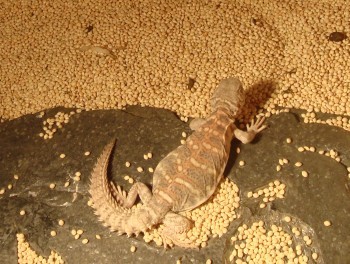 |
|
Housing
You can use Custom Wooden Enclosures, Plastic Enclosures, PVC Enclosures, Aquariums, Tubs, Metal Stock Tanks, Etc. The main thing is the more room you can provide your Uromastyx the happier it will be. Approximately 2 Ft X 4 Ft for one animal, 2 Ft X 6 Ft for two to three animals.
I house all of my Uromastyx separately 100 percent of the time. Uromastyx live alone in the wild in cracks on rocky cliffs and some species live in borrows but they do not share living quarters in the wild and I keep them the same way in captivity one per enclosure. I find that I have better growth rates and healthier animals then I did when I used to house them in pairs. Make sure to offer at least one hide per Uro to be housed together. I keep a hide in the hot end of the cage and one in the cool end of the cage. This gives the Uromastyx a choice of temperatures that they can hide under. I keep 120-140 degree basking and a gradient of 75-85 degrees on the cool side. I use a good UV florescent type light and reflector type light for the basking spots. If you have a big enough enclosure and are housing 3 or more Uro’s you may even want to provide two basking lights just make sure to give a gradient so they can escape the heat if they want.
I have switched all my Uromastyx enclosures to bare floor and or tile floor. I was using Zilla White Proso Millet as a substrate and it works great for Uromastyx that are not scheduled to breed. Female Uromastyx that lay there eggs in Millet cause a nightmare. It is almost imposable to dust off the Millet off the eggs and once the eggs are placed in the incubator and left for a few days the Millet will sprout and damage the eggs. I had one of my WC U. O. Ocellata lay 6 eggs and she just laid them on top of the millet which stuck to the eggs. I was afraid to wash them off in water so I dusted off as much of the millet as I could and put the eggs into the incubator and several days later the millet sprouted and I ended up loosing the eggs.
I highly discourage anyone using sand as a substrate. Elizabeth Lynch pointed out that most playsand and pool filter sand is made up of 93.2 – 93.6% silica. Elizabeth Lynch wrote: “Inhalation of Silica can cause Silicosis. Silicosis is a serious lung disease that can lead to pulmonary failure. The frequency and amount inhaled Silica can effect the severity, but it is certainly a real risk with using these substances in our hot and dry enclosures. I know a lot of people say the pool filter sand has no dust, but the problem is- the particles of silica may be so fine that you cannot see them. Silicosis can happen regardless of how much dust you can see, or not see.” I already have asthma and breathing problems and as much as I love sand it is not worth it to me.
|
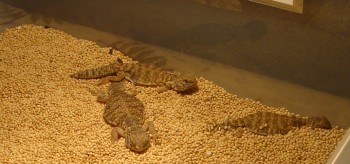 |
|
New Uro’s
When acquiring new Uromastyx always try to purchase captive breed from a reputable breeder. Captive breed Uromastyx do better in captivity, they have do not have any parasites and by purchasing captive breed you are not supporting harvesting from the wild and importation which many Uromastyx do not survive.
If you decide to establish breeding pairs of Uromastyx is the one time it is acceptable to purchase wild caught Uromastyx. Setting up Uromastyx breeding pairs or breeding projects is the one time it is acceptable to purchase wild caught Uromastyx as the goal in such situations is to establish breeding groups of Uromastyx that will produce captive breed hatchling Uromastyx and hopefully decrease or eliminate harvesting Uromastyx from the wild and importation.
The main thing to avoid when acquiring Uromastyx always avoid purchasing gravid females, It may seem like a good idea as there is a chance you could get eggs and produce hatchlings, but in reality wild caught gravid Uromastyx do not adjust well and quite often will not lay there eggs which ends up killing them due to being egg-bound. If you get the chance to choose which wild caught Uromastyx you purchase it is suggested that you get young hatchlings or juveniles as they seem to adjust to captivity better. If you are purchasing adults look for ones of good weight that appear healthy. Check there vents for feces smear and stay away form ones with an unclean vent.
As far as acclimating Uromastyx;
- House them separately. Make sure and provide an enclosure of at least a 2 Ft X 4 Ft enclosure for each Uromastyx.
- Provide 120-140 degree basking and UVB lighting.
- Cover any of the see through sides of the enclosure.
- Here is an example of one of my covered enclosures.
- Make sure there are hides under the basking spot and on the cool side of the cage.
Feeding a mix of Spring Mix, Endive, Escarole, Dandelions, Dandelion Greens, Mustard Greens, Turnip Greens, Collard Greens, Bok Choy, and some Kale. Also offer edible flowers such as Hibiscus, Hollyhock, Dandelion, Cat’s Ear, Birds Foot Trifoil, Etc. Lightly dust their food with indoor version of Miner All calcium supplement once to twice per month if at all. With proper diet and proper UVB they really do not need it.
Keep a small bowl of uncooked (ground up) green peas, lentils, various beans and birdseed. Occasionally add pure bee pollen granules to the ground up green peas, lentils, various beans, birdseed mix. Do not offer the peas, lentils, various beans and birdseed if the Uromastyx is less than 6 months – 1 year old.
Never feed Uromastyx insects, Studies of Uromastyx in the wild show they are completely herbivorous, and insects are harmful to their liver in the long term.
Weigh your Uromastyx every month to assure it is not loosing weight. It should steadily gain weight or at least maintain weight once it gets used to its soundings.
I do not treat my Uromastyx for parasites, but many people do. If you chose to treat your Uromastyx, make sure and take a fresh fecal to a qualified veterinarian and let the veterinarian test for parasites and follow veterinarian instructions for type of medicine and dosage.
For me the secrete of acclimating Uromastyx is:
- housing them separately
- providing proper cage size lighting, and food
- Not feeding any insects
- and not handling the Uromastyx except for cleanings and weighing
|
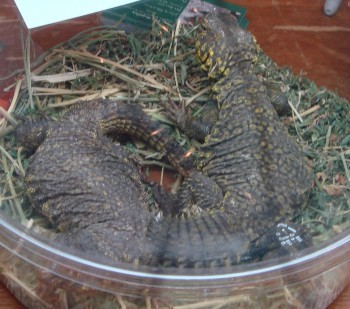 |
|
Mature Uromastyx
There are at least 18 species of Uromastyx. See the Reptilles Database for descriptions and pictures of the 18 species of Uromastyx .
Uromastyx mature in like 3-5 years depending on care and environment. At around 3 years or so they become old enough to breed and reproduce. All my U.ornate females that have produced eggs for me so far have weighed at least 200 grams. My Ocellata was only 120 grams and she laid eggs. So it depends on the species you are working with when it will be mature and ready for breeding.
Audrey Vanderlinden actually bred 1 yr. old U.ornates. (See the UROMASTYX HOME PAGE -The Captive breeding update on Ornate Spiny Tailed Lizards)
|
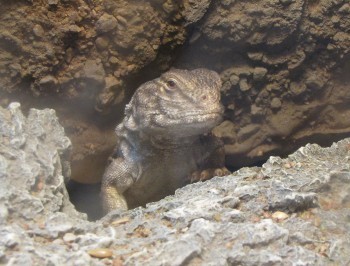 |
|
Uromastyx are a long lived species and have been reported reaching 10+ years in captivity. I believe with proper diet and care they can far exceed this, maybe even go to the 20+ years old range.
|
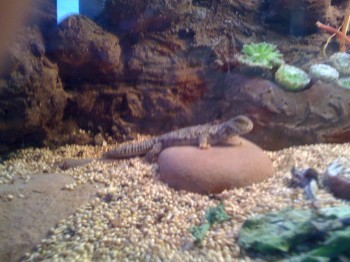 |
|
Uromastyx Brumation schedule
I did a light brumation in 2009 due to all my adult Uromastyx are wild caught and I have had them for less then one year. I did not want to put them into a hard brumation for fear of them getting sick or dieing. Plus I have had conversations with other breeders that are having successful mating and producing hatchlings with little or no brumation.
2010 Brumation schedule;
December 6th 2009; Stop feeding all who are going to brumate this year. Vacuumed allseeds and extra food in the enclosures of those to going to brumate this year to make sure that absolutely no food or seed is left in enclosures of those going to brumate this year.
December 19th 2009; Turned off basking and florescent UVB lighting on those to going to brumate this year.
January 9th 2010; Reset Lights, Start Feeding and resumed normal feeding and light schedule
I did offer 4 hours of basking lights and florescent lights every Saturday or Sunday but no food was offered for the whole period.
1999 Brumation schedule;
Sifted sand in all enclosures of Uro’s to be hibernated to make sure no food left in sand
November 28th 1999
Stop feeding all who are going to hibernate this year.
** Need to give them a couple weeks to pass the food in there stomachs, prior to turning out the lights
December 11th 1999 Cut out all lights on those who are going to Hibernate
I did offer the U.ornates 4 hours of basking lights and florescent lights every Wednesday and Saturday but no food was offered for the whole period.
U.ornates do not seem to go into a deep hibernation, seems like more of a brumation. I offer short basking time a couple times a week and did observe them basking on many occasions.
January 2rd or 9th 2000 Reset Lights, Start Feeding and resumed normal feeding and light schedule
Warning: There is always risk when hibernation or brumating Uromastyx. Please do not hibernate / brumate unless you are serious about breeding Uromastyx. There is a health risk and hibernation / brumation has even resulted in death in some collectors collections.
The above method worked for me to produce fertile eggs. I realize it is not the most scientific method that can be used, and Brumation may not even be needed. I have had conversations with a breeder of Benti and Mails that does not brumate and he has hatched many successful clutches with out cooling his lizards.
|
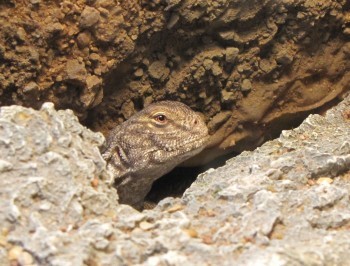 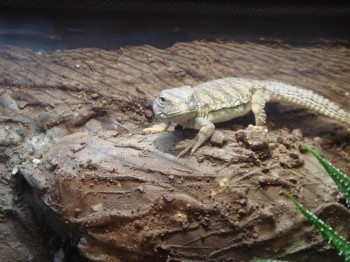 |
|
Mating rituals
My female keeps flipping on her back when I put her in the males enclosure. Are they mating? Yes this is mating behavior, but it is not mating. The female flipping on her back is her way of saying not tonight. If the male circles around on the females belly and lays on top of her, they are not mating. The male circling on the females back and or circling on the females belly is like a pre breeding activity. The male will also do push ups and case the females around the enclosures. Many times a white substance is left on the females back during these pre breeding activities and unsuccessful breeding.
Once the male is serious about breeding and the female is ready the male will bite a fold of her skin around her neck and hang on to it.
He may even pull the female around the enclosure by this fold of skin. Once the male has the female wore out or the female is ready to breed, He will position himself on her back. He will wiggle his tail by the side of the females tail until she gives in and raises her tail, he will then wrap his tail under hers all the while still biting and holding on by the skin around her neck. He will position his vent over hers and insert his hemi penis, He will hold her in this mating position for 2-10 minutes.
If the breading is successful and the female becomes gravid, she will lay her eggs in 4-6 weeks. Uromastyx mating can be violent and is not for weak of heart.
Egg Laying
Once your female Uromastyx becomes gravid (Pregnant) , or you suspect she is gravid, I advise you move her cadge mate to there own separate enclosure. That is if you are housing them as pairs. Females become aggressive once they become gravid, and they will defend the egg laying site quite viciously. I have even seen a case where the female caused fatal wounds to the male being housed with her, when he got a little to curious about her egg laying site.
Around mid January to the first of February, I add egg laying sites to my adult female U.ornate cadges. I use small rubber made plastic containers. Around the size of a shoe box, maybe a little smaller. I cut 4-5 inch square hole in the lid of the plastic container. I fill the containers with a vermiculite sand mix and add enough water to make the mix kind of sticky. I take my plastic container and place it in the cool end of the females enclosure. I add these egg laying sites some time between January to the first of February to give the females a chance to get used to them being in there cadges.
If I notice gravid females not willing to visit the egg laying site on the cool end I move it to the warm end of the cage. I had a female Uromastyx that laid an egg, just out in the sand. She was looking very miserable and lumpy and would not even go in her egg laying box. I was talking with Mark Walsh and he mentioned trying warming the box or move it to the hot end of the cage. Since I did not have any hand warmers, I moved the site to the warm end of the cadge. I had only relocated the site about a hour before and the female U.ornate was already digging in it like crazy. She laid 13 eggs that evening.
I also increase the calcium intake to my adult females around this time of the year. I dust there foods a couple times of week, some of the other breeders use Neo-Calglucon (calcium glubionate). They administer via an eye dropper. This is to increase the calcium levels in females to hopefully aide in egg formation.
Around mid January to the first of February I begin introducing the females into the males enclosures for brief visits. I watch them closely and if any breeding is witnessed I document date and which of Uromastyx breed. It will be around 4 to 5 weeks from the time of breeding to when she lays her eggs. Females will some times dig for days or even weeks to get there egg laying site the way that satisfies them. Once the female is comfortable with her site she will lay her eggs. The females may lay their eggs over several hours, I have had females lay some one day and finish laying the next day.
Once you discover the female has laid her eggs. Usually the female is noticeable deflated right after laying. I ware rubber gloves and carefully remove the eggs from the egg laying sites, being very careful to gently place them in the incubation plastic containers the same way that they are laid. There has been some speculation turning eggs can sometimes harm the eggs. I space the eggs a inch or so apart in the incubation container. Once all eggs are transferred to the incubation contained I seal the lid and place the in the incubator. See egg incubation section for more info.
I offer water to females after laying their eggs, to try to rehydrate them. Egg laying really take a toll on the females, but usually within a week or two they gain back most of there weight and begin to resume normal feeding and basking.
|
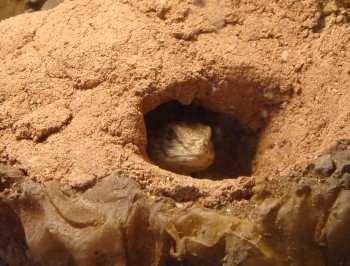 |
|
Troy Jones incubation method.
Here is how I did incubation back in 1998-2000
U. Ornate eggs 1999
The first year I hatched them out I used a hova-bator. I filled the bottom of the hova-bator with moist vermiculite around three to one vermiculite to water ratio until the vermiculite covered the screen shelf That comes with the hova-bator’s, I covered the screen around a couple inches worth of the vermiculite. I made indentations in the vermiculite and placed the eggs straight into the vermiculite in the hova-bator no containers, I had a small container of water in the corner to help with humidity and incubated the eggs at 86-89 degrees. That first year my female laid 4 infernal yellow eggs and then 21 days later she laid 8 fertile ones of which I hatched out 7 of them.
The second year 3 of my females laid eggs all around the same time so I opted to incubate them in separate containers. I punched pin holes in the top of the plastic containers and filled them full of moist vermiculite, with a one to three ratio of water to vermiculite. On the first and second clutch the lids were only lightly placed on the plastic containers. After the first clutch failed I noticed that the plastic containers did not seem to be building up any moisture on the inside so I sealed the second container and moisture did build up, but then so did the mold I lost all but one of the eggs.
On clutch number three I added the eggs to the plastic container and sealed the lid from day one. Moisture built up and all eight of these eggs hatched. I did mist the lids of the plastic containers around once a month and had a small separate container of water in the incubator. Incubation temperatures were 86-89 degrees. Clutch one and two were from females that had never laid before but clutch number three was from the same female I was successful with the first year. Unfortunately I did not get to try a 3rd year as our house got hit by a tornado and I was forced to sell my collection. I have since learned that misting the lids is a bad idea as it is best not to add moisture where it can come in contact with the egg. If you need to add moisture use a syringe and add it in the corners where it does not come in contact with the eggs.
|
|
|
Mark Walsh incubation method;
Here is Mark Walsh incubation method Danny Molco ( The author of (Data from Wild Populations) Ornate Spiny Tailed-Lizards by Ben David Osnat and Molco Danny (Copyright 1999) feels that his method is the best.
05/14/2001 Mark Walsh egg incubation is as follows:
The substrate is a 50/50 mix of perillite and the fine vermiculite, I start with 60/40 ratio for the first two weeks and then let it dry to 70/30. A good tip, when getting the trays together, put them in the microwave for about 20 seconds, this will sterilize the substrate. Be sure to weigh your trays with a digital scale for accuracy. After adding the eggs cover the trays and leave one small hole (approx .125″)for oxygen exchange. I start the eggs at 93° for the first 30 days and then go to 94° for the duration. At the time of expected hatching I raise the temp to 95°. I am currently using a Helix incubator which uses forced air heating, this helps keep the heat consistent through out the incubator. I keep the humidity at 80%, this keeps the trays from drying out too fast and having to add water all the time. It is a good idea to weigh your trays once a week to track evaporation levels. With all of this maintained, your eggs should hatch in approx. 60 days.
09/11/2009 Thomasi2 from Taiwan incubation method.
I use Hova incubator, but I don’t use it’s auto-heating system
I use heat tape to continue heating to maintain Temp to about 33~35*C
About humidity , out side the eggs container the water is filled so it’s humidity is very high.
But in the container the humidity is very low , the weight of substrate : water about 5:1
almost dry, I also put the mix in the button and a little dry substrate on it
But in the late phase, especially when babies is coming out, I will add humidity or put some well moistened paper towel with the eggs.
Anyway I had a lot of egg failures due to mold, either I got the vermiculite to moist and the eggs would mold or I would get them to dry and they would crash. For me repeating successful incubation even using the same method is hit and miss at best and I am still studding trying to get a method that I can repeat year after year.
If you have successfully hatched out Uromastyx and are willing to share your methods please email me and I will post it in this section of my web page. Please include your full name, what you hatched out, how many times your method has worked for you, your success rate, what years you hatch out Uromastyx and describe your method is as much detail as possible. Send an email to troy@uroranch with incubation in the subject field. I am an believer in sharing information to better everyone’s efforts to successfully hatch Uromastyx eggs. I appreciate those of you willing to share.
Hatchling care
Once hatched out my Uromastyx hatchlings started feeding in the first day or two. They are fed the same basic greens as the adults only all stems are removed and the greens are finely chopped. You may want to offer hatchlings access to daily water in a shallow container. Make sure it can not be tipped over and only leave it in the enclosure for a few hours a day. I do not offer water, but some other species seem to benefit from it. If I notice an animal looking dehydrated I will offer water. I do not offer crushed seeds, lentils, peas, beans or any of these type dry foods until hatchlings are 6-12 months of age.
Danny Molco Author of (Data from Wild Populations) Ornate Spiny Tailed-Lizards) states “It is very important to put a parent’s dry drops (fecal) in the hatchling cage for the first few days.” This may aid in the hatchlings developing stomach flora. Make sure if adding the parents fecal to the hatchlings enclosure that the parents have been tested for parasites, so nothing is unintentionally passed to the hatchlings.
My hatchlings are housed each in there own separate enclosure with similar basking and gradients as the adults. 120-130 degrees basking with a gradient to 75-85 degrees on the cool side. If your hatchlings are looking dehydrated back off your basking temperatures a little and or offer some water in a shallow container.
I house the hatchlings on paper towels, tile and bare floor. Do not try other substrate until the hatchlings are at least 6 months to a year old.
The above article was reprinted with the permission of Troy Jones from Uroranch.com – Please visit his site to learn more about these fascinating animals…
Troy Jones Uro Care Sheet www.uroranch.com – Excellent source of uromastyx – author of above article
Deer Fern FarmsAn excellent source of Uromastyx and they have provided the top photo used in this article.
|
|